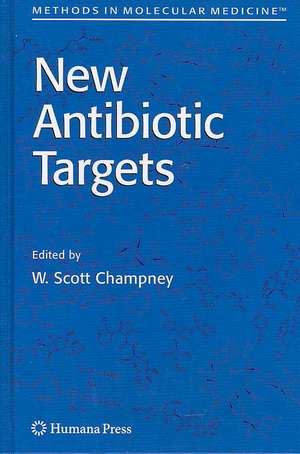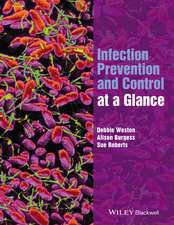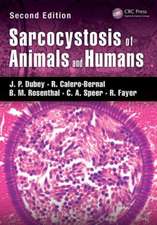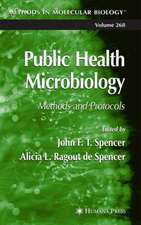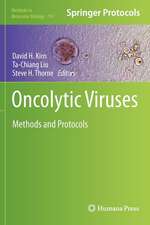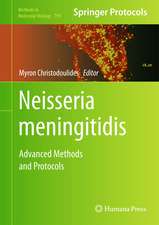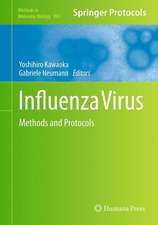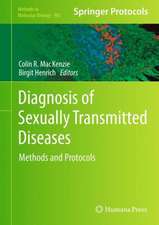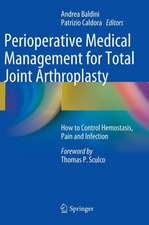New Antibiotic Targets: Methods in Molecular Medicine, cartea 142
Editat de W. Scott Champneyen Limba Engleză Hardback – 15 ian 2008
“New Antibiotic Targets” provides laboratory investigators with the vital tools they need to test the antimicrobial potential of products and to curb the rise of so many infectious diseases.
| Toate formatele și edițiile | Preț | Express |
|---|---|---|
| Paperback (1) | 898.37 lei 6-8 săpt. | |
| Humana Press Inc. – 10 noi 2010 | 898.37 lei 6-8 săpt. | |
| Hardback (1) | 723.42 lei 6-8 săpt. | |
| Humana Press Inc. – 15 ian 2008 | 723.42 lei 6-8 săpt. |
Din seria Methods in Molecular Medicine
- 5%
 Preț: 1278.74 lei
Preț: 1278.74 lei - 15%
 Preț: 655.78 lei
Preț: 655.78 lei - 5%
 Preț: 1106.50 lei
Preț: 1106.50 lei - 5%
 Preț: 727.44 lei
Preț: 727.44 lei - 5%
 Preț: 1108.72 lei
Preț: 1108.72 lei - 15%
 Preț: 650.55 lei
Preț: 650.55 lei - 5%
 Preț: 735.66 lei
Preț: 735.66 lei - 18%
 Preț: 947.35 lei
Preț: 947.35 lei - 18%
 Preț: 948.92 lei
Preț: 948.92 lei - 5%
 Preț: 1114.54 lei
Preț: 1114.54 lei - 5%
 Preț: 1114.91 lei
Preț: 1114.91 lei - 15%
 Preț: 658.55 lei
Preț: 658.55 lei - 5%
 Preț: 734.01 lei
Preț: 734.01 lei - 5%
 Preț: 1111.61 lei
Preț: 1111.61 lei - 5%
 Preț: 1104.32 lei
Preț: 1104.32 lei - 5%
 Preț: 723.21 lei
Preț: 723.21 lei - 5%
 Preț: 1106.13 lei
Preț: 1106.13 lei - 5%
 Preț: 723.05 lei
Preț: 723.05 lei - 5%
 Preț: 1108.35 lei
Preț: 1108.35 lei - 5%
 Preț: 723.42 lei
Preț: 723.42 lei - 5%
 Preț: 1115.65 lei
Preț: 1115.65 lei - 5%
 Preț: 786.86 lei
Preț: 786.86 lei - 5%
 Preț: 1133.01 lei
Preț: 1133.01 lei - 5%
 Preț: 1114.71 lei
Preț: 1114.71 lei
Preț: 723.42 lei
Preț vechi: 761.49 lei
-5% Nou
Puncte Express: 1085
Preț estimativ în valută:
138.42€ • 144.92$ • 114.54£
138.42€ • 144.92$ • 114.54£
Carte tipărită la comandă
Livrare economică 05-19 aprilie
Preluare comenzi: 021 569.72.76
Specificații
ISBN-13: 9781588299154
ISBN-10: 1588299155
Pagini: 288
Ilustrații: XII, 274 p. 51 illus.
Dimensiuni: 155 x 235 x 20 mm
Greutate: 0.61 kg
Ediția:2008
Editura: Humana Press Inc.
Colecția Humana
Seria Methods in Molecular Medicine
Locul publicării:Totowa, NJ, United States
ISBN-10: 1588299155
Pagini: 288
Ilustrații: XII, 274 p. 51 illus.
Dimensiuni: 155 x 235 x 20 mm
Greutate: 0.61 kg
Ediția:2008
Editura: Humana Press Inc.
Colecția Humana
Seria Methods in Molecular Medicine
Locul publicării:Totowa, NJ, United States
Public țintă
ResearchCuprins
Biocomputational Strategies for Microbial Drug Target Identification.- Methods to Assay Inhibitors of DNA Gyrase and Topoisomerase IV Activities.- A Method to Assay Inhibitors of DNA Polymerase IIIC Activity.- Methods to Identify and Characterize Inhibitors of Bacterial RNA Polymerase.- Methods to Assay Inhibitors of tRNA Synthetase Activity.- Three Methods to Assay Inhibitors of Ribosomal Subunit Assembly.- Inhibition ofChaperone-Dependent Bacterial Ribosome Biogenesis.- Assays for the Identification of Inhibitors Targeting Specific Translational Steps.- SPARK: A New Peptidyl Transferase Activity Assay.- High-Throughput Screening of Peptide Deformylase Inhibitors.- A Method to Assay Penicillin-Binding Proteins.- A Method to Assay Inhibitors of Lipopolysaccharide Synthesis.- Methods for Assessing the Structure and Function of Cationic Antimicrobial Peptides.- Flow Cytometry of Bacterial Membrane Potential and Permeability.- Bacterial Efflux Pump Inhibitors.- Mycobacterium tuberculosis ?-Ketoacyl Acyl Carrier Protein Synthase III (mtFabH) Assay: Principles and Method.- Screening for Compounds That Affect the Interaction Between Bacterial Two-Component Signal Transduction Response Regulator Protein and Cognate Promoter DNA.- The Activity of rRNA Resistance Methyltransferases Assessed by MALDI Mass Spectrometry.- Assays for ?-Lactamase Activity and Inhibition.- Studies of Enzymes That Cause Resistance to Aminoglycosides Antibiotics.
Recenzii
From the reviews:
"This book describes, in specific detail, a variety of methods used to identify cellular components of bacteria that would be good targets for antibiotics. … Those working in laboratories on discovery of new antibiotics are the intended audience. The book is easy to follow and written in a step-wise fashion. It would be easy for laboratory technicians as well as graduate students to follow. … This is a good methods book that contains the latest information on new techniques." (Rebecca T. Horvat, Doody’s Review Service, May, 2008)
"The contributors to each chapter are good and well known names in their fields, providing good coverage of their subjects. I think this book will find utility in the field of drug discovery and target identification specifically from compound libraries … ." (Paul Hoskisson, Microbiology Today, July, 2008)
"This book describes, in specific detail, a variety of methods used to identify cellular components of bacteria that would be good targets for antibiotics. … Those working in laboratories on discovery of new antibiotics are the intended audience. The book is easy to follow and written in a step-wise fashion. It would be easy for laboratory technicians as well as graduate students to follow. … This is a good methods book that contains the latest information on new techniques." (Rebecca T. Horvat, Doody’s Review Service, May, 2008)
"The contributors to each chapter are good and well known names in their fields, providing good coverage of their subjects. I think this book will find utility in the field of drug discovery and target identification specifically from compound libraries … ." (Paul Hoskisson, Microbiology Today, July, 2008)
Textul de pe ultima copertă
A crisis is developing in the treatment of infectious diseases, with microorganisms frequently showing resistance to currently prescribed antibiotics. Fewer and fewer antimicrobial agents are now available to treat these infections. In "New Antibiotic Targets," W. Scott Champney examines specific techniques which can be used to explore new drug targets and the effectiveness of new antibiotics. By testing new antimicrobial agents and modified existing drugs, the most vulnerable cell processes, such as cell wall and membrane synthesis, DNA replication, RNA transcription and protein synthesis, can be better exploited. This in-depth volume, however, delves even deeper by identifying additional novel cellular targets for these new therapies.
With detailed methods and protocols for the identification and assay of these targets, "New Antibiotic Targets" provides laboratory investigators with the vital tools they need to test the antimicrobial potential of products and to curb the rise of so many infectious diseases.
With detailed methods and protocols for the identification and assay of these targets, "New Antibiotic Targets" provides laboratory investigators with the vital tools they need to test the antimicrobial potential of products and to curb the rise of so many infectious diseases.
Caracteristici
Features novel drug targets including peptide deformylase, ribosome formation, lipopolysaccharide and fatty acid biosynthesis and signal transduction pathways. Includes new methods for the assay of RNA polymerase, peptide bond formation, translational initiation, ribosome biogenesis and membrane permeability, as well as methods for target identification by bacterial genome searches Details the activity of novel inhibitors of DNA polymerase, peptide deformylase, membrane transport, efflux pumps and beta-lactamases
